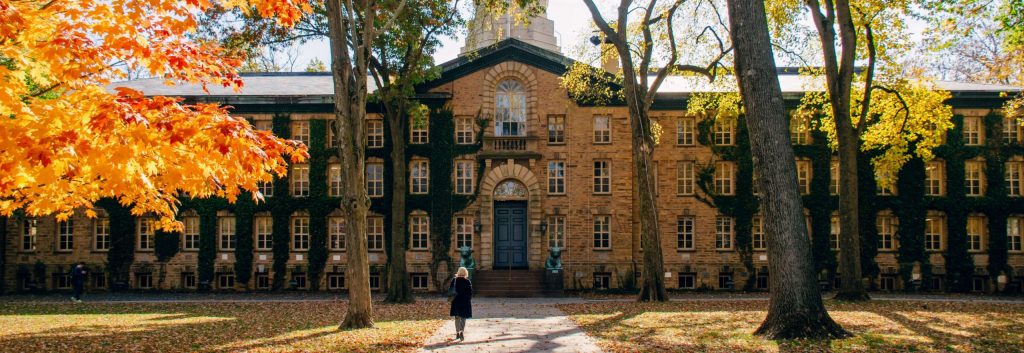Student-centric advice and objective recommendations
Higher education has never been more confusing or expensive. Our goal is to help you navigate the very big decisions related to higher ed with objective information and expert advice. Each piece of content on the site is original, based on extensive research, and reviewed by multiple editors, including a subject matter expert. This ensures that all of our content is up-to-date, useful, accurate, and thorough.
Our reviews and recommendations are based on extensive research, testing, and feedback. We may receive commission from links on our website, but that doesn’t affect our editors’ opinions. Our marketing partners don’t review, approve or endorse our editorial content. It’s accurate to the best of our knowledge when posted. You can find a complete list of our partners here.
What are Princeton Eating Clubs?
 By
Zach Skillings
By
Zach Skillings 
Zach Skillings is the Scholarships360 Newsletter Editor. He specializes in college admissions and strives to answer important questions about higher education. When he’s not contributing to Scholarships360, Zach writes about travel, music, film, and culture. His work has been published in Our State Magazine, Ladygunn Magazine, The Nocturnal Times, and The Lexington Dispatch. Zach graduated from Elon University with a degree in Cinema and Television Arts.
Full BioLearn about our editorial policies

Maria Geiger is Director of Content at Scholarships360. She is a former online educational technology instructor and adjunct writing instructor. In addition to education reform, Maria’s interests include viewpoint diversity, blended/flipped learning, digital communication, and integrating media/web tools into the curriculum to better facilitate student engagement. Maria earned both a B.A. and an M.A. in English Literature from Monmouth University, an M. Ed. in Education from Monmouth University, and a Virtual Online Teaching Certificate (VOLT) from the University of Pennsylvania.
Full BioLearn about our editorial policies

Dating back to 1879, eating clubs are a rich tradition at Princeton University. These clubs originated as dining halls, but today they are centers for socializing and studying. In this guide, we’ll cover everything you need to know about Princeton eating clubs.
Related: How to create a budget as a college student
What are eating clubs?
Unique to Princeton University, eating clubs are co-ed social organizations for juniors and seniors at the school. Joining a club is optional, but 68% of upperclassmen are currently members. Those who join must pay annual membership fees. The first club (Ivy) was established in 1879 as a result of the university’s lack of dining facilities. Although they originally served as comfortable spaces for students to have meals, eating clubs have evolved a lot over the years.
The clubs still serve as dining halls, but these days they’re places for students to socialize, study, and relax as well. Throughout the school year, clubs throw parties, put on concerts, and host other events. Members participate in activities such as field trips, formals, movie nights, and mini-golf. Eating clubs also perform community service, host educational events such as guest lectures, and sponsor intramural athletic programs.
Eating club facilities have also improved a lot over the years. Within most club buildings you’ll find libraries, study spaces, and recreational rooms equipped with amenities like pool tables and TVs. There are currently 11 clubs, each with a distinctive character.
Related: What is Ivy Day?
Eating clubs overview
| Selective clubs | Non-selective clubs |
| Cannon Dial Elm | Charter |
| Cap and Gown | Cloister Inn |
| Cottage | Colonial |
| Ivy | Quadrangle |
| Tiger Inn | Terrace |
| Tower |
Selective (bicker) eating clubs
Cannon Dial Elm
- House: The Cannon clubhouse has three stories plus the largest basement on Prospect Avenue. The house has special rooms for music and cards for its members to enjoy. The most notable feature of the Cannon house is the Revolutionary War period cannon stationed in the front yard
-
- Food: The club’s dining room accommodates for the unique orders of each of the members where members can add, subtract and mix and match their meal to their liking
- Total club members: 219
- Junior/Senior dues: $9,900
- Sophomore (spring) dues: $750
Cap and Gown
- House: The Cap and Gown clubhouse contains a lot of amazing amenities such as a fireplace, a sunporch, a brand-new taproom, and much more
-
- Food: The Cap and Gown club has private chefs that whip up breakfasts, lunches and dinners. Additionally, they have Thursday Dinner Club Nights which are members only events with special meals and themed drinks
- Total club members: 312
- Junior/Senior dues: $10,698
Cottage
- House: The Cottage clubhouse contains incredible features such as great marble fireplaces and rooms paneled in English oak
-
- Food: The Cottage offers breakfast, lunch and dinner on weekdays and brunch and dinner on weekends. This menu features authentic foods from different countries and flavor profiles
- Total club members: 170
- Junior/Senior dues: $9,300
- Sophomore (spring) dues: $750
Ivy
- House: Ivy has many extravagant rooms such as a beautiful library filled with thousands of books and a tap room that doubles as a dance floor
-
- Food: Breakfast is cooked to order every morning. The lunch and dinner menus change daily and there are always vegetarian options as well as grilled chicken and a salad bar
- Total club members: 160
- Junior/Senior dues: $12,100
- Sophomore (spring) dues: $1,300
Tiger Inn
- House: Tiger Inn’s architecture best follows the theme of the English inn by containing a stone fireplace and a board wooden staircase that leads to the library
-
- Food: Tiger Inn offers a diverse menu with weekly staples mixed in
- Total club members: 189
- Junior/Senior dues: $9,800
- Sophomore (spring) dues: $950
Tower
- House: Tower offers many fun rooms to hang out in, such as the Coat Room, the Pogue Room (a “cozy” media room), the Tap Room, the Game Room, and much more
-
- Food: High quality food can be made to order
- Total club members: 220
- Junior/Senior dues: $10,017
- Sophomore (spring) dues: $950
Non-selective eating clubs
Charter
- House: Charter’s clubhouse offers a lot of great amenities such as a sand volleyball court, a beautiful library, a TV room and much more
-
- Food: Some days a buffet is offered and other days it is a served dinner with waiters
- Total club members: 180
- Junior/Senior dues: $9,500
Cloister Inn
- House: Collegiate Gothic-style mansion that offers a big backyard with a volleyball court, a hot tub, a library and much more
-
- Food: The Cloister Inn culinary team responds to requests through an online suggestion box and adds these requests to their menu
- Total club members: 83
- Junior/Senior dues: $9,500
- Sophomore (spring) dues: $800
Colonial
- House: Colonial has one of the largest clubhouses with a gorgeous front lawn, a magnificent dining hall, and a relaxing common room
-
- Food: Colonial provides a variety of culinary options for members
- Total club members: 172
- Junior/Senior dues: $8,982
- Sophomore (spring) dues: $800
Quadrangle
- House: Quadrangle offers wheelchair access to many beautiful rooms such as the Grand Salon, the Balcony, and the Billiards Room
-
- Food: Quad prioritizes food diversity and options making sure they have options for all dietary restrictions
- Total club members: 88
- Junior/Senior dues: $10,350
- Sophomore (spring) dues: $800
Terrace
- House: Music is the backbone of Terrace! So, there are many opportunities to express yourself through music at the Terrace clubhouse such as producing tracks in the Green Room or listening to classical music in the Piano Room
-
- Food: Daily vegan and vegetarian options are ample as the kitchen strives to accommodate all dietary needs
- Total club members: 180
- Junior/Senior dues: $9,500
- Sophomore (spring) dues: $800
Are eating clubs like fraternities and sororities?
Although similar to Greek life organizations in many ways, eating clubs are not considered fraternities or sororities. Eating clubs differentiate themselves from Greek life in two main ways – they’re co-ed (all clubs accept both men and women) and they’re not residential. With the exception of some club officers, no club members actually live in the buildings.
Related: What are public ivy leagues?
How do I join an eating club?
Students are eligible to join a club during the spring semester of their sophomore year, which is when most students join. Admission procedures vary depending on the club you want to join. Some clubs have a selective admissions process (called “bicker”), while others have a non-selective process (called “sign-in”). The bicker process involves applying for membership, going through interviews, and competing for a bid from a current member.
Unaccepted students can apply to “sign-in” clubs, which operate on a first-come, first-serve basis. If more students sign in than a club can accept, a lottery randomly selects members. All clubs, both bicker and sign-in, host events for sophomores to learn more about the clubs and meet current members.
Also see: What is room and board in college?
How much do memberships cost?
Eating club memberships typically cost $9,000 – $10,000 per year. Although eating clubs are more expensive than other dining options, students pay for more than just a meal plan. Membership grants access to all the social opportunities that come along with being in an eating club. Most clubs try to make membership more affordable for lower-income students, and financial aid is also available from the university.
Also see: How to pay for housing
Acknowledging the past…
While eating clubs are wildly popular at Princeton, they haven’t always been welcoming to all students. Eating clubs have faced their fair share of controversy over the years, including accusations of being elitist and discriminatory. During the 1949-1950 academic year, for instance, 15 Jewish students claimed they had been excluded from the clubs based on their religion. And while eating clubs are currently co-ed, for a couple decades they excluded women from membership. All clubs adopted the co-ed policy only after a New Jersey Supreme Court ruling made it mandatory.
These days, however, the clubs seem to be more open and welcoming than ever before. In 2020, the Interclub Council (composed of the 11 club presidents) wrote a letter acknowledging their troubled past and their plans to increase equality among the clubs. While this is encouraging for anyone looking to become a member, it’s important to do your own research if you’re thinking of joining a club. Each club is different and has its own personality, so the best way to decide is to make an in-person visit and meet some of the current members.
Also see: How to get involved on campus
Lifetime membership
If you decide to join an eating club, the benefits of membership are not limited to your time in college. Eating club memberships last for life, and alumni frequently return to campus for homecoming games and reunions. Many Princeton students and alumni say that their closest friendships were formed with their clubmates.
Related: The Ivy League: What it is and where schools rank
Overview of the eating clubs
The Princeton eating clubs are an important aspect of the social and dining scene. These clubs are primarily open to juniors and seniors and offer a variety of dining options and social events for members. Each eating club has a house with a variety of amenities along with amazing culinary staff who prepare delicious food for members.
There are two types of eating clubs you can join, either a selective or non-selective club. Bicker or selective clubs have a selection process while non-selective clubs have a more straightforward membership. Each club has its own unique culture and traditions and students can choose the eating club that best fits their preferences.
In addition to food, eating clubs host a wide range of social activities such as formals or study breaks. Therefore, it’s extremely important to research and understand the practices of each club before joining.
Additionally, financial aid is available to help students cover the costs of joining an eating club. Overall, the Princeton eating clubs offer an opportunity for students to socialize and enjoy good food while attending college.
Frequently asked questions about Princeton Eating Clubs
Do eating clubs have housing for members?
Why join an eating club?
What if I cannot afford to join an eating club?
What is the difference between a bicker and a sign-in club?
How do I learn more about an eating club I am interested in?
Can I be a member of multiple eating clubs?
Are there any academic benefits to joining an eating club?
Can I join an eating club if I have an allergy?
What social activities do eating clubs organize?




 SAT" printed on his pencil">
SAT" printed on his pencil">
